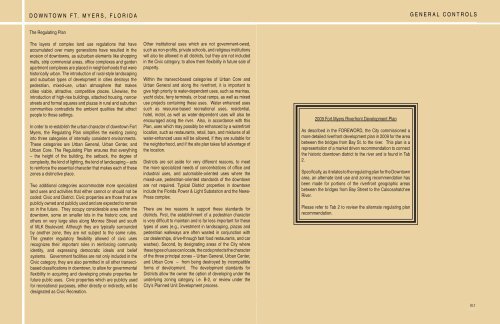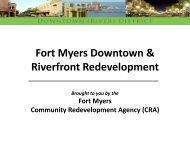DOWNTOWN FT. MYERS, FLORIDAANALYSISThe Community Redevelopment Act RequirementsChapter 163, Part III, Florida Statutes (the CommunityRedevelopment Act of 1969), as amended contains therequirements to be met by this <strong>Plan</strong> for its use as the newcommunity redevelopment plan for downtown <strong>Fort</strong> <strong>Myers</strong>.The Act requires that this <strong>Plan</strong> show by diagram and ingeneral terms those specifi c plan requirements set forthin s. 163.362(2), Florida Statutes, including open space,street layout, building limitations, dwelling units, and otherpublic improvements. The General Controls section of the<strong>Plan</strong>, which follows, addresses each of these elements.Also required under the Act is the identifi cation of publiclyfunded capital projects to be undertaken. Street reconfi gurationsare shown in the General Controls section of the<strong>Plan</strong>, Parking Garage relocation plans are outlined in theAnalysis section, and additional desirable projects, whilenot mandatory, are depicted as Specifi c Interventions. Theaccompanying Streetscape <strong>Plan</strong> identifi es landscaping,lighting, and other streetscape treatments for downtown.The Act also requires that adequate safeguards exist thatthe work of redevelopment will be carried out pursuant tothe <strong>Plan</strong>. This assurance can be made by noting that theCity’s Comprehensive <strong>Plan</strong> and land development regulationsfor downtown are in the process of being modifi ed toconform to the recommendations set forth in this document.No displacement of residents is anticipated as a resultof the <strong>Plan</strong>, however, as a general policy, relocationshall conform to uniform relocation requirements, andreplacement housing shall be assured, should any unanticipatedtemporary or permanent displacement occuras a result of specifi c action of the <strong>Fort</strong> <strong>Myers</strong> CommunityRedevelopment Agency or the City of <strong>Fort</strong> <strong>Myers</strong>.As noted throughout the Specifi c Interventions section,the <strong>Plan</strong> provides for the retention of controls andestablishment of restrictions on land sold or leased forprivate use. In addition, the Analysis section providesstandards for municipal land leases or sale in the case ofcondominium development, as required by Chapter 163.II.8
DOWNTOWN FT. MYERS, FLORIDAGENERAL CONTROLSThe Regulating <strong>Plan</strong>The layers of complex land use regulations that haveaccumulated over many generations have resulted in theerosion of downtowns, as suburban elements like shoppingmalls, strip commercial areas, offi ce complexes and gardenapartment complexes are placed in neighborhoods that werehistorically urban. The introduction of rural-style landscapingand suburban types of development in cities destroys thepedestrian, mixed-use, urban atmosphere that makescities viable, attractive, competitive places. Likewise, theintroduction of high-rise buildings, attached housing, narrowstreets and formal squares and plazas in rural and suburbancommunities contradicts the ambient qualities that attractpeople to those settings.In order to re-establish the urban character of downtown <strong>Fort</strong><strong>Myers</strong>, the Regulating <strong>Plan</strong> simplifi es the existing zoninginto three categories of internally consistent environments.These categories are Urban General, Urban Center, andUrban Core. The Regulating <strong>Plan</strong> ensures that everything– the height of the building, the setback, the degree ofcomplexity, the kind of lighting, the kind of landscaping – actsto reinforce the essential character that makes each of thesezones a distinctive place.Two additional categories accommodate more specializedland uses and activities that either cannot or should not becoded: Civic and District. Civic properties are those that arepublicly owned and publicly used and are expected to remainso in the future. They occupy considerable area within thedowntown, some on smaller lots in the historic core, andothers on very large sites along Monroe Street and southof MLK Boulevard. Although they are typically surroundedby another zone, they are not subject to the same rules.The greater regulatory fl exibility allowed of civic usesrecognizes their important roles in reinforcing communityidentity, and expressing democratic ideals and beliefsystems. Government facilities are not only included in theCivic category, they are also permitted in all other transectbasedclassifi cations in downtown, to allow for governmentalfl exibility in acquiring and developing private properties forfuture public uses. Civic properties which are publicly usedfor recreational purposes, either directly or indirectly, will bedesignated as Civic Recreation.Other institutional uses which are not government-owed,such as non-profi ts, private schools, and religious institutionswill also be allowed in all districts, but they are not includedin the Civic category, to allow them fl exibility in future sale ofproperty.Within the transect-based categories of Urban Core andUrban General and along the riverfront, it is important togive high priority to water-dependent uses, such as marinas,yacht clubs, ferry terminals, or boat ramps, as well as mixeduse projects containing these uses. Water enhanced usessuch as resource-based recreational uses, residential,hotel, motel, as well as water-dependent uses will also beencouraged along the river. Also, in accordance with this<strong>Plan</strong>, uses which may possibly be enhanced by a waterfrontlocation, such as restaurants, retail, bars, and mixtures of allwater-enhanced uses will be allowed, if they are suitable forthe neighborhood, and if the site plan takes full advantage ofthe location.Districts are set aside for very different reasons, to meetthe more specialized needs of concentrations of offi ce andindustrial uses, and automobile-oriented uses where themixed-use, pedestrian-oriented standards of the downtownare not required. Typical District properties in downtowninclude the Florida Power & Light Substation and the News-Press complex.There are two reasons to support these standards fordistricts. First, the establishment of a pedestrian characteris very diffi cult to maintain and is far less important for thesetypes of uses (e.g., investment in landscaping, plazas andpedestrian walkways are often wasted in conjunction withcar dealerships, drive-through fast food restaurants, and carwashes). Second, by designating areas of the City wherethese types of uses can locate, the code protects the characterof the three principal zones – Urban General, Urban Center,and Urban Core – from being destroyed by incompatibleforms of development. The development standards forDistricts allow the owner the option of developing under theunderlying zoning category, i.e. B-2, or review under theCity’s <strong>Plan</strong>ned Unit <strong>Development</strong> process.2009 <strong>Fort</strong> <strong>Myers</strong> Riverfront <strong>Development</strong> <strong>Plan</strong>As described in the FOREWORD, the City commissioned amore detailed riverfront development plan in 2009 for the areabetween the bridges from Bay St. to the river. This plan is arepresentation of a market driven recommendation to connectthe historic downtown district to the river and is found in Tab2.Specifi cally, as it relates to the regulating plan for the <strong>Downtown</strong>area, an alternate land use and zoning recommendation hasbeen made for portions of the riverfront geographic areasbetween the bridges from Bay Street to the CaloosahatcheeRiver.Please refer to Tab 2 to review the alternate regulating planrecommendation.III.1
- Page 1: 2 0 1 0D O W N T O W NP L A NPREPAR
- Page 7 and 8: DOWNTOWN FT. MYERS, FLORIDAFOREWORD
- Page 9 and 10: DOWNTOWN FT. MYERS, FLORIDAFOREWORD
- Page 11 and 12: DOWNTOWN FT. MYERS, FLORIDAPUBLIC P
- Page 13 and 14: DOWNTOWN FT. MYERS, FLORIDAIDENTIFI
- Page 15 and 16: DOWNTOWN FT. MYERS, FLORIDAPLAN ADO
- Page 17: D O W N T O W NF O R T M Y E R SAPR
- Page 21 and 22: DOWNTOWN FT. MYERS, FLORIDAEXECUTIV
- Page 23: DOWNTOWN FT. MYERS, FLORIDAEXECUTIV
- Page 26 and 27: 0 200 400 800 1,600 ftDOWNTOWN FT.
- Page 28 and 29: DOWNTOWN FT. MYERS, FLORIDAANALYSIS
- Page 30 and 31: DOWNTOWN FT. MYERS, FLORIDAANALYSIS
- Page 34 and 35: DOWNTOWN FT. MYERS, FLORIDAGENERAL
- Page 36 and 37: DOWNTOWN FT. MYERS, FLORIDAGENERAL
- Page 38 and 39: DOWNTOWN FT. MYERS, FLORIDAGENERAL
- Page 40 and 41: DOWNTOWN FT. MYERS, FLORIDAProposed
- Page 42 and 43: DOWNTOWN FT. MYERS, FLORIDATHE HEAR
- Page 44 and 45: DOWNTOWN FT. MYERS, FLORIDASPECIFIC
- Page 46 and 47: DOWNTOWN FT. MYERS, FLORIDABAY STRE
- Page 48 and 49: DOWNTOWN FT. MYERS, FLORIDASPECIFIC
- Page 50 and 51: DOWNTOWN FT. MYERS, FLORIDASPECIFIC
- Page 52 and 53: DOWNTOWN FT. MYERS, FLORIDAWestern
- Page 54 and 55: DOWNTOWN FT. MYERS, FLORIDASPECIFIC
- Page 56 and 57: DOWNTOWN FT. MYERS, FLORIDAEdison S
- Page 58 and 59: DOWNTOWN FT. MYERS, FLORIDAEdison a
- Page 60 and 61: EVANS AVENUEDOWNTOWN FT. MYERS, FLO
- Page 62 and 63: DOWNTOWN FT. MYERS, FLORIDASPECIFIC
- Page 64 and 65: DOWNTOWN FT. MYERS, FLORIDASPECIFIC
- Page 66 and 67: DOWNTOWN FT. MYERS, FLORIDAAPPENDIX
- Page 69: RIVERFRONT DEVELOPMENT TEAM:ACKNOWL
- Page 73: EXECUTIVE SUMMARY 1
- Page 76 and 77: Charrette 1: Framework for DesignTh
- Page 78 and 79: RECOMMENDED MASTER PLANThe recommen
- Page 80 and 81: Guidelines SummaryDevelopment Guide
- Page 82 and 83:
Hotel Market Study SummaryHotel Stu
- Page 85:
INTRODUCTION 2
- Page 88 and 89:
PROJECT HISTORYIn August 2007, the
- Page 90 and 91:
PREVIOUS PLANNING EFFORTSThe Fort M
- Page 92 and 93:
Historic DistrictSTUDY AREASTUDY AR
- Page 94 and 95:
Figure Ground with Duany PlanFigure
- Page 96 and 97:
Downtown Parking CapacityA Downtown
- Page 98 and 99:
KEY PLANNING GOALSThe following lis
- Page 100 and 101:
Analysis Sketch - Development2-14 D
- Page 102 and 103:
Analysis Sketch - Open Space2-16 Op
- Page 104 and 105:
Charrette 2 HistoryDiagram delineat
- Page 106 and 107:
Option ABComparativeScale:3-D model
- Page 108 and 109:
South Florida ArchitectureThe Steer
- Page 111:
MASTER PLAN 3
- Page 114 and 115:
Illustrative PlanFORT MYERS RIVERFR
- Page 116 and 117:
Rendering 2Aerial view looking west
- Page 118 and 119:
Vehicular CirculationEDISON BRIDGEV
- Page 120 and 121:
Existing / New StructuresNew Struct
- Page 122 and 123:
Pedestrian CirculationTo Edison-For
- Page 124 and 125:
Waterfront Pedestrian EdgeWaterfron
- Page 126 and 127:
Land Use / Zoning (New)*Urban Cente
- Page 128 and 129:
Current/Future Proposed Land Use an
- Page 130:
Current/Future Proposed Land Use an
- Page 133 and 134:
Section through Edwards at Centenni
- Page 135 and 136:
Section through HendrySouth BasinWa
- Page 137:
RenderingsExpanded Harborside Event
- Page 141 and 142:
Development GuidelinesAs part of th
- Page 143 and 144:
Block A Guidelines5213147MONROE STR
- Page 145 and 146:
Block B Guidelines12 38714 56EDWARD
- Page 147 and 148:
Block C Guidelines1521643284BAY STR
- Page 149 and 150:
Block D Guidelines82186711EDWARDS D
- Page 151 and 152:
Block E Guidelines12JACKSON STREETJ
- Page 153 and 154:
Block F Guidelines1223213221341LEE
- Page 155 and 156:
EDWARDS DRIVEEDWARDS DRIVEBlock W1
- Page 157 and 158:
Block W2 Guidelines133125633657212H
- Page 159 and 160:
Block W4 Guidelines765314HENDRY STR
- Page 161 and 162:
Block W6 Guidelines212133421LEE STR
- Page 163 and 164:
Block P9W Guidelines14325Park Eleme
- Page 165:
Block P9E Guidelines46345214Park El
- Page 169 and 170:
Implementation Plan SummaryImplemen
- Page 171 and 172:
Site Plan Programmingpart 1 of 3For
- Page 173 and 174:
Site Plan Programmingpart 3 of 3For
- Page 175 and 176:
Project and Component Cost Modelpar
- Page 177 and 178:
Project and Component Cost Modelpar
- Page 179 and 180:
Project and Component Cost Modelpar
- Page 181 and 182:
Project and Component Cost Modelpar
- Page 183 and 184:
Project and Component Cost Modelpar
- Page 185 and 186:
Project and Component Cost Modelpar
- Page 187 and 188:
Project and Component Cost Modelpar
- Page 189 and 190:
Project and Component Cost Modelpar
- Page 191 and 192:
Project and Component Cost Modelpar
- Page 193 and 194:
Schedule of Regulatory Requirements
- Page 195 and 196:
NOTE: This development approval pro
- Page 197 and 198:
Preliminary Project Schedule and Ph
- Page 199 and 200:
Preliminary Project Schedule and Ph
- Page 201 and 202:
Preliminary Project Schedule and Ph
- Page 203 and 204:
Component Block E1 and F1-F2part 2
- Page 205 and 206:
Component Block E1 and F1-F2part 4
- Page 207 and 208:
Component Block W1, W2-W5 & W6-W7pa
- Page 209 and 210:
District Branding PlanMarketing and
- Page 211 and 212:
Preliminary Project Financial Forec
- Page 213 and 214:
Preliminary Project Financial Forec
- Page 215 and 216:
Preliminary Project Financial Forec
- Page 217 and 218:
Preliminary Project Financial Forec
- Page 219 and 220:
Assumptions for NMTC Transaction:NE
- Page 221 and 222:
Downtown Fort Myers Riverfront Mast
- Page 223 and 224:
Downtown Fort Myers Riverfront Mast
- Page 225 and 226:
Downtown Fort Myers Riverfront Mast
- Page 227 and 228:
Downtown Fort Myers Riverfront Mast
- Page 229 and 230:
Downtown Fort Myers Riverfront Mast
- Page 231 and 232:
Downtown Fort Myers Riverfront Mast
- Page 233 and 234:
Downtown Fort Myers Riverfront Mast
- Page 235 and 236:
Downtown Fort Myers Riverfront Mast
- Page 237 and 238:
Downtown Fort Myers Riverfront Mast
- Page 239 and 240:
Downtown Fort Myers Riverfront Mast
- Page 241 and 242:
Downtown Fort Myers Riverfront Mast
- Page 243 and 244:
FEMA MapFort Myers Riverfront Redev
- Page 245 and 246:
Grade Transition ViewsPlanPerspecti




